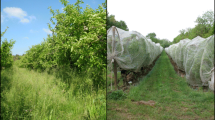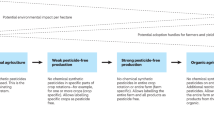Abstract
Plant protection in organic farming has to simultaneously comply with two sets of regulations: regulations on organic production and pesticide legislation. This chapter describes the organic approach to plant protection, including the role of systems management versus direct interventions, the range of authorised substances and the procedures for authorising new substances and the withdrawal of old substances.
External factors not related to organic farming also influence the availability of plant protection products. Scientific, regulatory and economic aspects may limit the registration of substances in a given country. On the other hand, there is an alternative route for the registration of fertilisers and plant strengtheners in some countries. As a result, the range of plant protection products available to organic farmers varies from one country to another. The history of the authorisation of sodium bicarbonate, spinosad, copper fungicides, clay minerals and granulosis viruses illustrates how the two sets of regulations can interact in very different ways, creating different patterns of availability.
The practice of plant protection is illustrated for the prevention and control of apple scab, fire blight and codling moth in organic apple orchards. At the end of the chapter, research perspectives for a ‘self-regulating’ apple orchard where plant protection fully relies on systems management are presented. The level of environmental friendliness already achieved by organic plant protection is discussed, and approaches with the potential for improvement are identified.
Access this chapter
Tax calculation will be finalised at checkout
Purchases are for personal use only
Similar content being viewed by others
Notes
- 1.
All EGTOP reports are published on the website: http://ec.europa.eu/agriculture/organic/eu-policy/expert-recommendations/expert-group_en.
- 2.
The category of plant strengtheners has recently been revised, and does not contain all of the mentioned substances any more
- 3.
The European Commission has recently funded a research project for ‘innovative strategies for copper-free low input and organic farming systems’; see http://ec.europa.eu/research/bioeconomy/agriculture/projects/co-free_en.htm. Accessed on 2012/09/14.
References
Andermatt M (2008) 20 years for MADEX—20 years for Andermatt Biocontrol AG. AG J 2008:2–3
Asser-Kaiser S, Fritsch E, Undorf-Spahn K, Kienzle J, Eberle KE, Gund NA, Reineke A, Zebitz CPW, Heckel DG, Huber J, Jehle JA (2007) Rapid emergence of baculovirus resistance in codling moth due to dominant, sex-linked inheritance. Science 317:1916–1918
Baker B (2004) Plant protection products in organic farming in the USA. In: Speiser B, Schmid, O (eds) Current evaluation procedures for plant protection products used in organic agriculture. Proceedings of a workshop held on 25–26 September, 2003 in Frick, Switzerland. FiBL, Frick, Switzerland, pp 66–72
Biondi A, Desneux N, Siscaro G, Zappala L (2012) Using organic-certified rather than synthetic pesticides may not be safer for biological control agents: selectivity and side-effects of 14 pesticides on the predator Orius laevigatus. Chemosphere 87:803–812
Blake F (2004) IFOAM policies concerning inputs evaluation. In: Speiser B, Schmid O (eds) Current evaluation procedures for plant protection products used in organic agriculture. Proceedings of o workshop held on 25–26 September, 2003 in Frick, Switzerland. FiBL, Frick, Switzerland, pp 74–79
Chemicals Regulation Directorate (2010) Data requirements and trials design for mating disruption pheromone products. v2 04/11/2010
Codex Alimentarius Commission (1999) Guidelines for the production, processing, labelling and marketing of organically produced foods. GL 32-1999. Rev 4-2007. Rome
Deguine JP, Penvern S (2014) Agroecological crop protection in organic farming: relevance and limits. In: Bellon S, Penvern S (eds) Organic farming, prototype for sustainable agricultures, Editions Springer, Chap.6
EC (1991) Council regulation No 2092/91 of June 24 1991 on organic production of agricultural products and indications referring thereto on agricultural products and foodstuffs. Official Journal of the European Communities L 198:1–15
EC (2002) Commission Regulation (EC) No 473/2002 of 15 March 2002, amending Annexes I, II and VI to Council Regulation (EEC) No 2092/91 on organic production of agricultural products and indications referring thereto on agricultural products and foodstuffs, and laying down the detailed rules as regards the transmission of information on the use of copper compounds. Official Journal of the European Communities L 75:21–24
EC (2007) Council Regulation (EC) No 834/2007 of 28 June 2007 on organic production and labelling of organic products and repealing Regulation (EEC) No 2092/91. Official Journal of the European Communities L 189:1–23
EC (2008a) Commission Regulation (EC) No 404/2008 of 6 May 2008 amending Annex II to Council Regulation (EEC) No 2092/91 on organic production of agricultural products as concerns the authorization of spinosad, potassium bicarbonate and copper octanoate and the use of ethylene. Official Journal of the European Communities L 120:8–10
EC (2008b) Commission Regulation (EC) No 889/2008 of 5 September 2008, laying down detailed rules for the implementation of Council Regulation (EC) No 834/2007 on organic production and labelling of organic products with regard to organic production, labelling and control. Official Journal of the European Communities L 250:1–84
EC (2009a) Commission decision of 3 June 2009 establishing the expert group for technical advice on organic production. Official Journal of the European Union L 139:29–31
EC (2009b) Commission directive 2009/37/EC of 23 April 2009 amending council directive 91/414/EEC to include chlormequat, copper compounds, propaquizafop, quizalofop-P, teflubenzuron and zeta-cypermethrin as active substances. Official Journal of the European Communities L 104:23–32
EC (2009c) Directive 2009/128/EC of the European parliament and of the council of 21 October 2009 establishing a framework for community action to achieve the sustainable use of pesticides. Official Journal of the European Union L 309:71–86
EC (2009d) Regulation (EC) No 1107/2009 of the European parliament and of the council of 21 October 2009 concerning the placing on the market of plant protection products and repealing council directives 79/117/EEC and 91/414/EEC. Official Journal of the European Communities L 309:1–50
EC (2010) Commission decision of 28 September 2010 appointing the members of the expert group for technical advice on organic production and drawing up the pool list. Official Journal of the European Union C 262:3–4
EC (2011) Commission implementing regulation (EU) No 540/2011 of 25 May 2011 implementing regulation (EC) No 1107/2009 of the European parliament and of the council as regards the list of approved active substances. Official Journal of the European Union L 153:1–186
Ehlers RU (2011) Cost-benefit, risk and trade-off analysis of regulation. In: Ehlers RU (ed) Regulation of biological control agents. Springer, pp 139–153
EPPO (2008) EPPO Guideline ‘Mating disruption pheromones’ (PP 1/264). Bulletin OEPP/EPPO Bulletin 38:322–325
Forster R, Micheloni C, Regouin E, Speiser B, Viñuela E (2008) Report of the ad-hoc expert group on pesticides in organic food production. Meeting on 22–23 January 2008. European Commission, Directorate F.5. Organic farming, Brussels. http://ec.europa.eu/agriculture/organic/eu-policy/expert-recommendations_en. Accessed 12 Jan 2011
Gessler C, Patocchi A, Sansavini S, Tartarini S, Gianfranceschi L (2006) Venturia inaequalis resistance in apple. Cr Rev Plant Sci 25:473–503
Häseli A, Weibel FP, Daniel C, Schmid A, Tamm L, Wyss E (2005) Pflanzenschutz im Biokernobstanbau. FiBL, Frick
Hauschild R (2011) Facilitations in the regulation of plant protection products containing baculoviruses. In: Ehlers RU (ed.) Regulation of biological control agents. Springer, pp 259–266
Holb I, Heijne B, Tamm L (in press) Organic apple disease management. In: Finckh MR, van Bruggen AHC, Tamm L (eds) Plant diseases management in organic agriculture. American Phytopathological Society, St. Paul
IFOAM (2006) IFOAM norms for organic production and processing. IFOAM
Isman MB (2006) Botanical insecticides, deterrents and repellents in modern agriculture and an increasingly regulated world. Annu Rev Entomol 51:45–66
Landwirtschaftliches Zentrum SG (2006) Neupflanzung von Hochstammobstbäumen im Rahmen von Vernetzungsprojekten und Pflanzaktionen Ministère de l’Agriculture et de la Pêche (2008) The Ecophyto 2018 plan
Ministère de l’agriculture et de la pèche (2008) The écophyto 2018 plan. http://agriculture.gouv.fr/IMG/pdf/PLAN_ECOPHYTO_2018_eng.pdf. Accessed 21 Nov 2013
OECD (2001) Guidance for registration requirements for pheromones and other semiochemicals used for arthropod pest control. Environment directorate. Organisation for Economic Co-operation and Development, Paris
OECD (2002) Consensus document on information used in the assessment of environmental applications involving baculoviruses. ENV/JM/MONO (2002) 1. OECD
SANCO (2008) Guidance Document on the assessment of new isolates of baculovirus species already included in Annex I of council directive 91/414/EEC. European Commission, Health and Consumer Protection Directorate-General. SANCO/0253/2008 rev. 2
Schärer HJ (2000) Feuerbrand, ein Dauerbrenner. Agrarforschung 7:404–409
Silvestri G, Egger S, Székely T, Weibel F (2008) Schorfresistente Sorten überzeugen Konsumentinnen und Konsumenten. Schweizerische Zeitung für Obst- und Weinbau 11/08: 10–13
Simon S, Rusch A, Wyss E, Sarthou JP (2014) Organic farming as an inspirational model for developing conservation biocontrol. In: Bellon S, Penvern S (eds) Organic farming, prototype for sustainable agricultures. Springer, Chap. 5
Speiser B, Schmid O (2004) Current evaluation procedures for plant protection products used in organic agriculture. Proceedings of a workshop held 25–26 September 2003 in Frick, Switzerland. FiBL, Frick
Speiser B, Wyss E, Maurer V (2006) Biological control in organic production: first choice or last option? In: Eilenberg J, Hokkanen H (eds) An ecological and societal approach to biological control. Springer, Dordrecht, pp 27–46
Speiser B, Tamm L, Mattock S (2011) Proposals for regulation of semiochemicals. In: Ehlers RU (ed) Regulation of biological control agents. Springer, pp 305–321
Speiser B, Stolze M, Oehen B, Gessler C, Weibel FP, Bravin E, Kilchenmann A, Widmer A, Charles R, Lang A, Stamm C, Triloff P, Tamm L (2012) Sustainability assessment of GM crops in a Swiss agricultural context. Agron Sus Dev 33(1):21–61
Strauch O, Strasser H, Hauschild R, Ehlers RU (2011) Proposals for bacterial and fungal biocontrol agents. In: Ehlers RU (ed) Regulation of biological control agents. Springer, pp 267–288
Tamm L, Häseli A, Fuchs JG, Weibel FP, Wyss E (2004) Organic fruit production in humid climates of Europe: bottlenecks and new approaches in disease and pest control. Acta Horticulturae 638:333–339
Tamm L, Thürig B, Fliessbach A, Goltlieb AE, Karavani S, Cohen Y (2011a) Elicitors and soil management to induce resistance against fungal plant diseases. NJAS—Wagen J Life Sc 58:131–137
Tamm L, Speiser B, Mercier T (2011b) Proposals for regulation of botanicals. In: Ehlers RU (ed) Regulation of biological control agents. Springer, pp 289–304
Weibel FP, Daniel C, Hammelehle A, Pfiffner L, Wyss E (2010) Potential and limits of pesticide free apple growing by a self-regulating orchard set-up: project presentation and first experience. Proceedings of the 14th international conference on organic fruit growing, Fördergemeinschaft Oekologischer Obstbau e.V. (FOEKO), Weinsberg, 22–24 Feb, pp 292–296
Weibel FP, Leder A (2007) Experiences with the Swiss (organic) method how to introduce new apple varieties into retail market: flavour group concept and variety team. Compact Fruit Tree 40:1–5
Weibel FP, Tamm L, Wyss E, Daniel C, Häseli A, Suter F (2007) Organic fruit production in Europe: successes in production and marketing in the last decade, perspectives and challenges for the future development. Proc. 1st Int. seminar on organic apple and pear. Acta Horticulturae 737:163–172
Willer (2011) Organic agriculture worldwide—the results of the FiBL/IFOAM survey. In: Willer H, Kilcher L (eds) The world of organic agriculture—statistics and emerging trends 2011. IFOAM/ FiBL, Bonn, pp 34–60
Zingg D, Kessler P (2008) Madex Plus und Madex I12 break virus resistance of codling moth. AG J 2008:10
Acknowledgments
We warmly thank Christian Schader for his expert advice on sustainability, and the anonymous referees for their helpful suggestions.
Author information
Authors and Affiliations
Corresponding author
Editor information
Editors and Affiliations
Rights and permissions
Copyright information
© 2014 Springer Science+Business Media Dordrecht
About this chapter
Cite this chapter
Speiser, B., Tamm, L., Weibel, F. (2014). Regulatory Framework for Plant Protection in Organic Farming. In: Bellon, S., Penvern, S. (eds) Organic Farming, Prototype for Sustainable Agricultures. Springer, Dordrecht. https://doi.org/10.1007/978-94-007-7927-3_4
Download citation
DOI: https://doi.org/10.1007/978-94-007-7927-3_4
Published:
Publisher Name: Springer, Dordrecht
Print ISBN: 978-94-007-7926-6
Online ISBN: 978-94-007-7927-3
eBook Packages: Biomedical and Life SciencesBiomedical and Life Sciences (R0)




